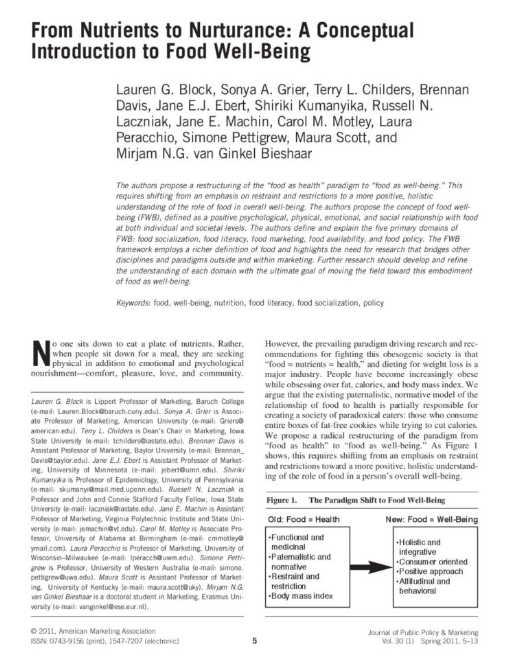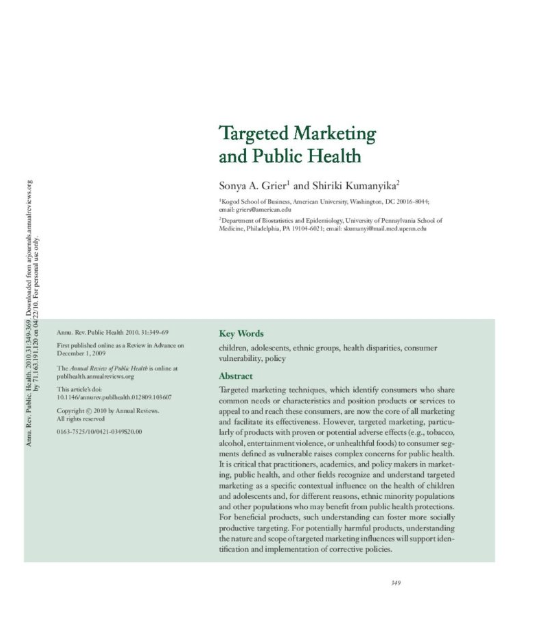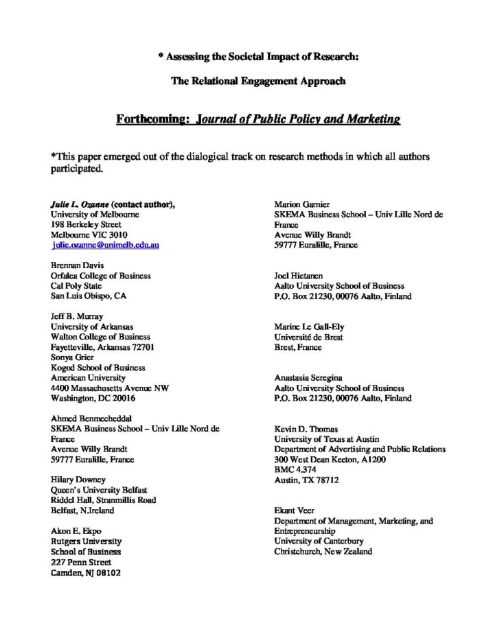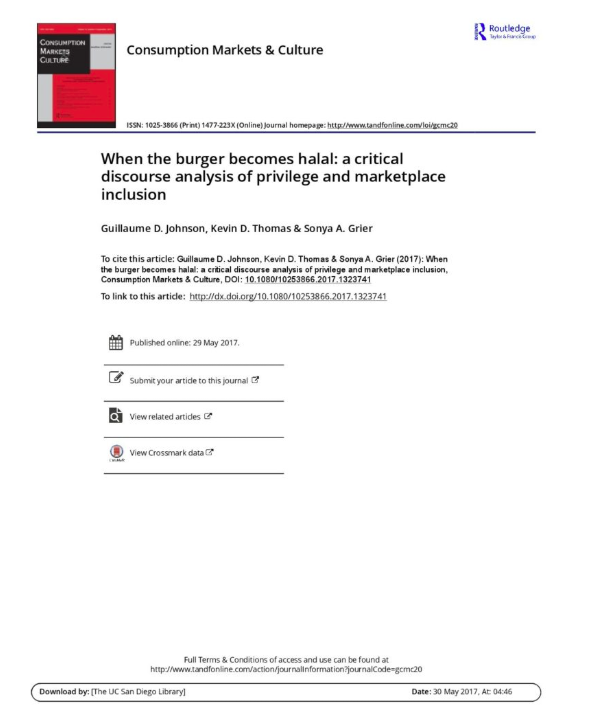Scholarship

I am a consumer researcher who investigates target marketing, which encompass strategies customized to particular consumer markets. Target marketing strategies may attempt to affect commercial behavior (e.g. “buy this product”), social behavior (e.g. “eat 9 fruits and vegetables a day to prevent cancer”) or some combination of the two (e.g. “buy this product and 10% of profits go to charity”). My research explains how important theoretical constructs and socio-contextual variables shape how consumers respond to target marketing, delineates important marketplace outcomes (both positive and negative).
My research findings are applicable to significant issues at the intersection of marketing and public policy and central to efforts to enhance consumer well-being. In addition, my research extends beyond the marketing discipline to academic and applied public health and public policy domains. My scholarship helps these audiences to benefit from consumer research expertise as they develop marketing-related programs and policies. Thus, I sit on the bridge of theory and practice addressing research questions of significant societal and managerial concern. Below I list the abstracts of a few published articles.
Published Research
Abstracts from select Publications
Re-imagining the Marketplace
Race is a marketplace icon. How so? By holding true to an icon’s defining characteristics: high visibility, divisiveness, and uncritical devotion. In this brief musing, we describe how despite its centrality to market activities, race is uncritically addressed in academic marketing research. We next introduce the Race in the Marketplace (RIM) Research Network, a newly- formed interdisciplinary collective of scholars and scholar-activists that seek to break race of its iconic standing and bring greater equity to markets by disseminating critical, collaborative, and transdisciplinary race-based market research that supports liberatory public policies and community actions. We close with a call to join our effort to reimagine the marketplace through the critical examination of what has been a perpetually overlooked icon in marketing academia.
Operating in a Constricted Space
Policy actors design and implement targeted interventions to eliminate disparities that exist between groups. Although necessary for achieving health equity, the use of targeting as a policy tool carries the potential for political backlash and social debate, which may influence whether and how policy actors use it. In this research, the authors examine policy actor perceptions regarding the use of targeting in the implementation of health policy. The authors conduct elite interviews with policy actors to better understand their work to design and implement interventions to address health disparities. Findings identify key tensions and trade-offs faced by policy actors related to targeting and reveal sociopolitical influences that shape whether and how targeted programs are considered, who receives them, and by what means they are delivered.
Dog-Parks and Coffee Shops
The process of gentrification, whereby lower-income residents are replaced with higher-income ones (Glass 1964), has changed the composition and character of hundreds of urban neighborhoods in cities worldwide. These changes affect not only the physical landscape but also the diversity of the people who live there. This research explores diversity seeking, consumption, and community in neighborhoods undergoing gentrification. The authors conducted a qualitative study of longer-term and newer residents in three neighborhoods in Washington, DC, to examine how the demographic changes that accompany gentrification relate to consumption. The findings suggest that diversity-seeking tendencies among newer residents were accompanied by tensions in the social and consumption domains, such that longer-term residents perceived exclusion and all residents experienced a reduced sense of community.
The Context for Choice
Targeted marketing of high-calorie foods and beverages to ethnic minority populations, relative to more healthful foods, may contribute to ethnic disparities in obesity and other diet-related chronic conditions. We conducted a systematic review of studies published in June 1992 through 2006 (n=20) that permitted comparison of food and beverage marketing to African Americas versus Whites and others. Eight studies reported on product promotions, 11 on retail food outlet locations, and 3 on food prices. Although the evidence base has limitations, studies indicated that African Americans are consistently exposed to food promotion and distribution patterns with relatively greater potential averse health effects than are Whites. The limited evidence on price disparities was inconclusive.
Targeted Marketing and Public Health
Targeted marketing techniques, which identify consumers who share common needs or characteristics and position products or services to appeal to and reach these consumers, are now the core of all marketing and facilitate its effectiveness. However, targeted marketing, particularly of products with proven or potential adverse effects (e.g., tobacco, alcohol, entertainment violence, or unhealthful foods) to consumer segments defined as vulnerable raises complex concerns for public health. It is critical that practitioners, academics, and policy makers in marketing, public health, and other fields recognize and understand targeted marketing as a specific contextual influence on the health of children and adolescents and, or different reasons, ethnic minority populations and other populations who may benefit from public health protections. For beneficial products, such understanding can foster more socially productive targeting. For potentially harmful products, understanding the nature and scope of targeted marketing influences will support identification and implementation of corrective policies.
Mindfullness
The authors propose that mindfulness is an antidote to mindless consumption, which adversely affects individual and collective well-being. The concept of mindfulness is explained and applied to the consumption context. More specifically, the authors examine mindful consumption as an ongoing practice of bringing attention, with acceptance, to inner and outer stimuli, and the effects of this practice on the consumption process. The transformative potential of mindful consumption is reviewed across domains of consumer, societal, and environmental well-being, with suggestions for future research. The article highlights some of the challenges to realizing the transformative potential of mindful consumption and concludes with suggestions for the actions that consumers, institutions, and policy makers could take to promote mindful consumption.




